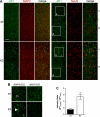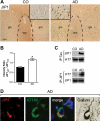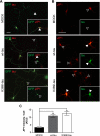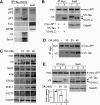Phosphorylated Tau interacts with c-Jun N-terminal kinase-interacting protein 1 (JIP1) in Alzheimer disease
- PMID: 19491104
- PMCID: PMC2742856
- DOI: 10.1074/jbc.M109.014472
Phosphorylated Tau interacts with c-Jun N-terminal kinase-interacting protein 1 (JIP1) in Alzheimer disease
Abstract
In Alzheimer disease (AD) and frontotemporal dementia the microtubule-associated protein Tau becomes progressively hyperphosphorylated, eventually forming aggregates. However, how Tau dysfunction is associated with functional impairment is only partly understood, especially at early stages when Tau is mislocalized but has not yet formed aggregates. Impaired axonal transport has been proposed as a potential pathomechanism, based on cellular Tau models and Tau transgenic mice. We recently reported K369I mutant Tau transgenic K3 mice with axonal transport defects that suggested a cargo-selective impairment of kinesin-driven anterograde transport by Tau. Here, we show that kinesin motor complex formation is disturbed in the K3 mice. We show that under pathological conditions hyperphosphorylated Tau interacts with c-Jun N-terminal kinase- interacting protein 1 (JIP1), which is associated with the kinesin motor protein complex. As a result, transport of JIP1 into the axon is impaired, causing JIP1 to accumulate in the cell body. Because we found trapping of JIP1 and a pathological Tau/JIP1 interaction also in AD brain, this may have pathomechanistic implications in diseases with a Tau pathology. This is supported by JIP1 sequestration in the cell body of Tau-transfected primary neuronal cultures. The pathological Tau/JIP1 interaction requires phosphorylation of Tau, and Tau competes with the physiological binding of JIP1 to kinesin light chain. Because JIP1 is involved in regulating cargo binding to kinesin motors, our findings may, at least in part, explain how hyperphosphorylated Tau mediates impaired axonal transport in AD and frontotemporal dementia.
Figures





Similar articles
-
Quantitative analysis of APP axonal transport in neurons: role of JIP1 in enhanced APP anterograde transport.Mol Biol Cell. 2014 Nov 5;25(22):3569-80. doi: 10.1091/mbc.E14-06-1111. Epub 2014 Aug 27. Mol Biol Cell. 2014. PMID: 25165140 Free PMC article.
-
JNK-interacting protein 1 mediates Alzheimer's-like pathological features in AICD-transgenic mice.Neurobiol Aging. 2015 Aug;36(8):2370-9. doi: 10.1016/j.neurobiolaging.2015.04.013. Epub 2015 Apr 30. Neurobiol Aging. 2015. PMID: 26022769
-
The JIP1 scaffold protein regulates axonal development in cortical neurons.Curr Biol. 2008 Feb 12;18(3):221-6. doi: 10.1016/j.cub.2008.01.025. Curr Biol. 2008. PMID: 18261906 Free PMC article.
-
"JIP"ing along the axon: the complex roles of JIPs in axonal transport.Bioessays. 2008 Jan;30(1):10-4. doi: 10.1002/bies.20695. Bioessays. 2008. PMID: 18081006 Review.
-
Current advances on different kinases involved in tau phosphorylation, and implications in Alzheimer's disease and tauopathies.Curr Alzheimer Res. 2005 Jan;2(1):3-18. doi: 10.2174/1567205052772713. Curr Alzheimer Res. 2005. PMID: 15977985 Review.
Cited by
-
Lessons from tau-deficient mice.Int J Alzheimers Dis. 2012;2012:873270. doi: 10.1155/2012/873270. Epub 2012 Jun 6. Int J Alzheimers Dis. 2012. PMID: 22720190 Free PMC article.
-
Yeast as a model system to study tau biology.Int J Alzheimers Dis. 2011 Apr 6;2011:428970. doi: 10.4061/2011/428970. Int J Alzheimers Dis. 2011. PMID: 21559193 Free PMC article.
-
MSUT2 regulates tau spreading via adenosinergic signaling mediated ASAP1 pathway in neurons.Acta Neuropathol. 2024 Mar 12;147(1):55. doi: 10.1007/s00401-024-02703-3. Acta Neuropathol. 2024. PMID: 38472475 Free PMC article.
-
The role of tau kinases in Alzheimer's disease.Curr Opin Drug Discov Devel. 2010 Sep;13(5):595-603. Curr Opin Drug Discov Devel. 2010. PMID: 20812151 Free PMC article. Review.
-
Tau as a potential therapeutic target for ischemic stroke.Aging (Albany NY). 2019 Dec 16;11(24):12827-12843. doi: 10.18632/aging.102547. Epub 2019 Dec 16. Aging (Albany NY). 2019. PMID: 31841442 Free PMC article. Review.
References
-
- Lee V. M., Goedert M., Trojanowski J. Q. (2001) Annu. Rev. Neurosci. 24, 1121–1159 - PubMed
-
- Goedert M., Spillantini M. G., Jakes R., Rutherford D., Crowther R. A. (1989) Neuron 3, 519–526 - PubMed
-
- Alonso A. C., Grundke-Iqbal I., Iqbal K. (1996) Nat Med 2, 783–787 - PubMed
-
- Chen F., David D., Ferrari A., Götz J. (2004) Curr. Drug Targets 5, 503–515 - PubMed
Publication types
MeSH terms
Substances
LinkOut - more resources
Full Text Sources
Other Literature Sources
Medical
Research Materials
Miscellaneous

